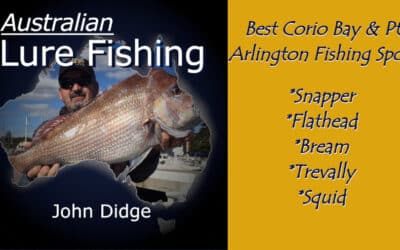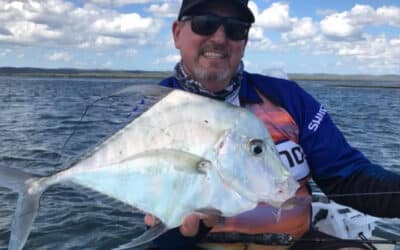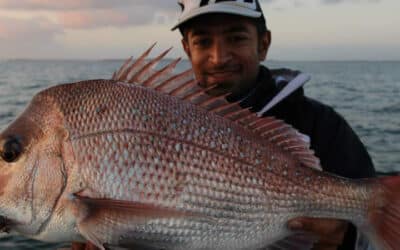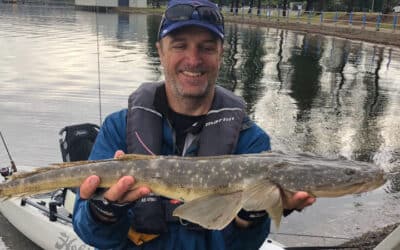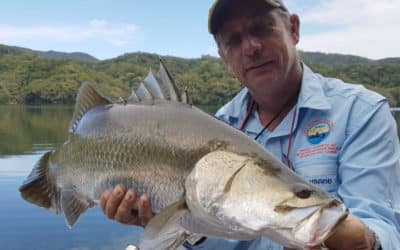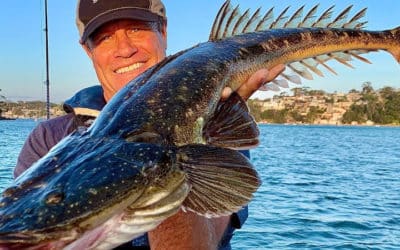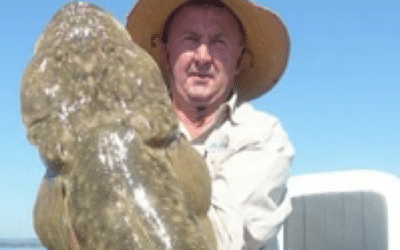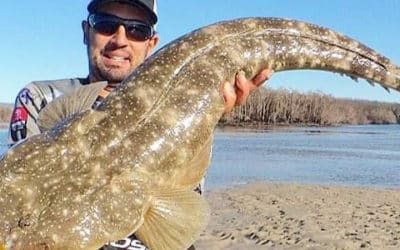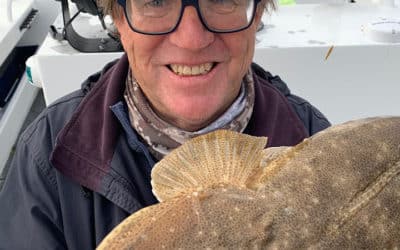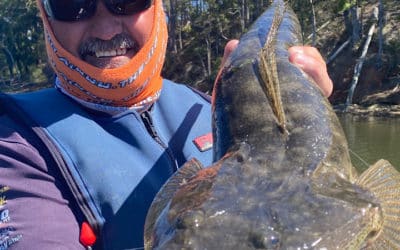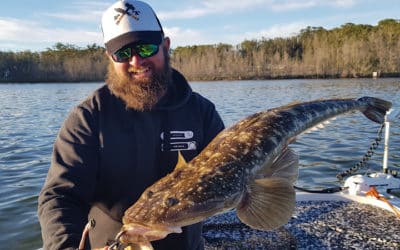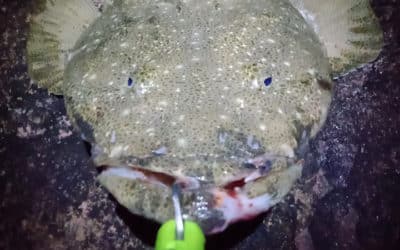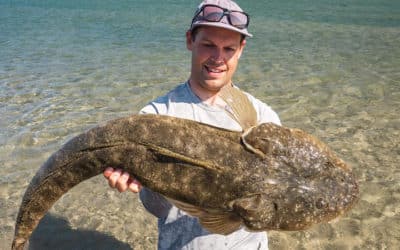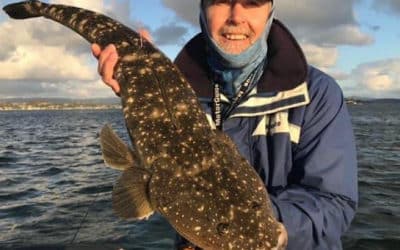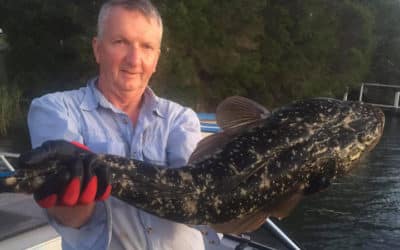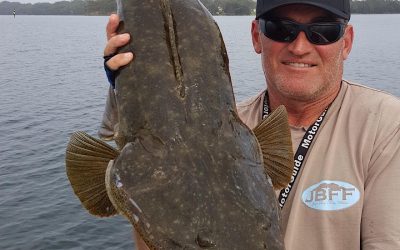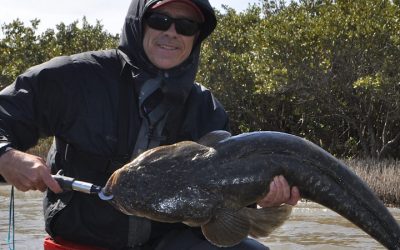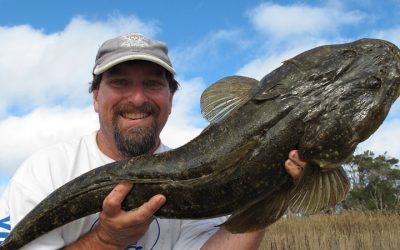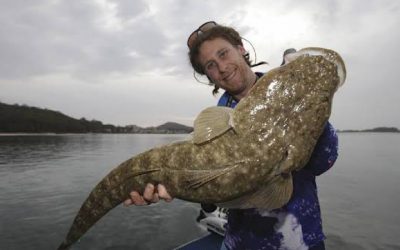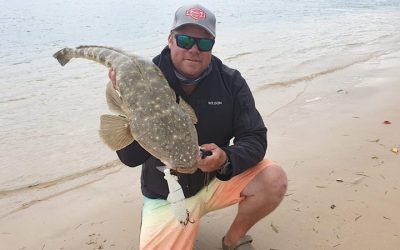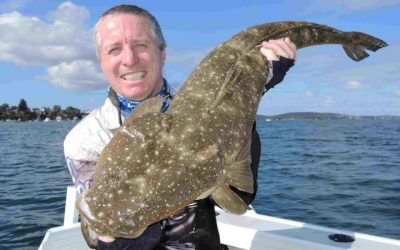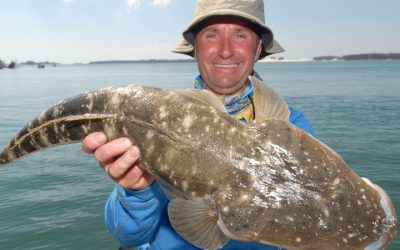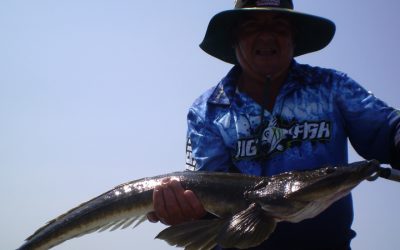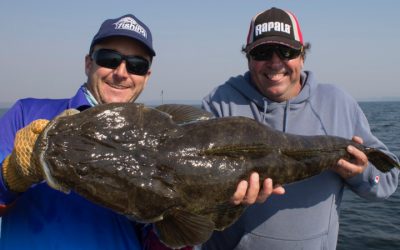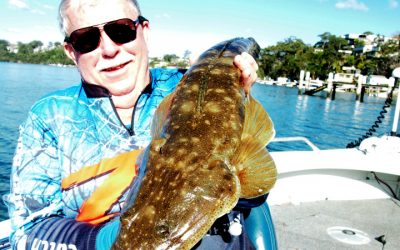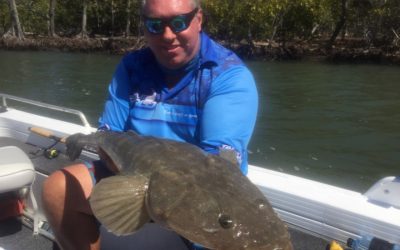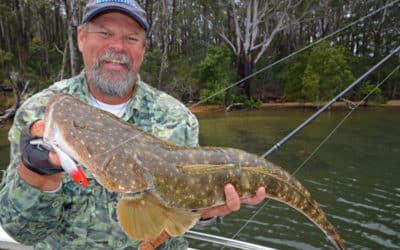This is ALF EPISODE...
Flathead Fishing: Ultimate Guide For Lure Fishers
With Tips From Over 30 Of Australia’s Best Flattie Whisperers
Welcome to the ultimate guide for targeting flathead with lures. Designed for the Australian lure fisher, this comprehensive resource will transform experienced anglers into flathead elites with pro tips, gear recommendations, and detailed techniques.
- Outgoing tides: The outgoing tide is a prime window for flathead fishing, concentrating baitfish and making flathead location and behaviour more predictable. As the tides run out you should focus on areas that baitfish are forced to retreat to. Drains, gutters and holes that contain water as the flats around them drain are prime territory. Flathead usually lie in wait as baitfish and prawns are swept into these areas.
- Incoming tides: Don’t overlook the incoming tide, especially around shallow feeding grounds. Trophy flathead often move up with the advancing water, sitting in just a few inches of water where hapless baitfish congregate to avoid other predators.
- Seasonal behaviors: It’s important to understand season factors and how they influences the best times for flathead fishing. These factors vary both by species and location, so it’s worth catching some of the podcast interviews below to get more specific information.
- Low light periods: Tidal factors tend to be the key to finding the best times for flathead fishing, matching various stages of the tide and water movement to the habitat where flathead will wait in ambush. But flatties also live in places that don’t have so much tide, and so low light periods can become more important. Like most species, flathead tend tobecome more active around first and last light, so these are great times to focus efforts in less tidal areas.
- Weather: A large proportion of my podcast guests have shared their preference for flathead fishing on days when there is a little wind and/or a little cloudiness or colour to the water. Flathead are ambush feeders and use these conditions to surprise prey. But wind ripple and water colour also provide cover for anglers wanting to avoid spooking fish.
Understanding Flathead And Their Environment
Before diving into the technicalities, it’s vital to grasp the typical habitats and behaviors of flathead. They’re predominantly found on sandy bottoms near seagrass or structures, utilizing these environments to effectively ambush prey. Weather conditions, such as a light breeze or a slight freshwater influx, can significantly influence flathead behavior, making it crucial to choose the right spots and times for fishing.
Strategic Positions: Channels and Drop-offs
Channels and drop-offs are prime hunting grounds for flathead, who use these deeper areas to ambush prey. When scouting these fishing spots, observe that flathead often position themselves facing into the current. This strategic placement allows them to spot baitfish and prawns being swept towards them, guiding you on where to find fish and how to effectively work your lures—typically with the current. Employing a strategy of working along contours and methodically fanning casts can greatly enhance your chances of a successful catch.
The Underwater Camouflage: Weed Beds and Sandy Flats
The fringes of weed beds and transitions to sandy flats are often spotlighted by experienced anglers as top flathead territories. Flathead use these areas with broken bottom compositions for camouflage, lying in wait to strike at unsuspecting prey. They frequently traverse along linear structures like weed bed edges or transitions from sand to rock or mud. Thoroughly working these areas can significantly increase your encounters with these cunning predators.
The Estuarine Maze
Estuaries present a complex maze of structures that are crucial for successful flathead fishing. From oyster racks to mangrove roots, pinpointing spots where flathead are likely to hide and ambush prey requires refined skills and experience. Moreover, the dynamic nature of estuaries, especially after rainfall, creates unique fishing opportunities due to changing conditions, making these areas exceptionally rewarding for those targeting flathead.
Essential Gear and Lures For Flathead Fishing
Selecting the right gear is pivotal for flathead fishing. Here, we discuss the optimal setups recommended by experts:
Rod and Reel
Flathead are clean fighters, even large fish can usually be played out on light gear with a little care. However, many of the lures that are effective on bigger flathead are large and heavy. So, rods and reels are generally matched to the lures that are being used. The choice of rod and reel setups varies depending on the style of fishing:
- Light Tackle: Ideal for casting light lures. Typically, a 6’6” to 7’7” rod paired with a 2500-3000 size reel, equipped with 4-5kg braided mainline and 5-8kg fluorocarbon leader, facilitates easy casting of very light lures over good distances.
- Medium Tackle: Suitable for larger lures and deeper water, featuring rods up to 7’6” long, a 3000-4000 size reel, 8kg braided line, and an 8-10kg leader, which allows for effective use of heavier jig heads and soft vibes.
- Heavy Tackle: Designed for the largest lures like large swimbaits and glidebaits. A rod ranging from 7’ to 7’6”, a 200-300 size baitcast reel, 15kg braid, and 15kg fluorocarbon leader make up this setup, perfect for targeting the biggest flathead.
Lures
Flathead will take a massive range of lures – the trick is to know which lure to use and when. Lure choice is aligned with water depth and conditions and the habitat in which the fish are being targeted. Among the lures commonly used in flathead fishing are topwater stickbaits and bent minnows, soft plastics (paddle tails, jerk shads, slugs and creatures), diving minnows, blades and soft vibes. Selection is based on whether fishing is done in shallow water (0-2m) or deeper water (>2m), flathead behaviour and local bait species.
Pro Flathead Fishing Tips
Over the years we have had over 30 guests on the Australian Lure Fishing Podcast specifically to talk about lure fishing for flathead. That great wealth of knowledge is available on this website by going to the show notes pages for each specific episode. However, I thought it would be useful to pull a key tip from each episode and share it here. Enjoy!
Fishing Near Structure - Russell Babekuhl, Forster Flathead
Your Subtitle Goes Here
Russell emphasizes the importance of fishing near structures such as oyster racks, especially during specific tidal movements. He recommends using topwater lures during the last hour of the run-in tide and the first hour of daylight for optimal results. Clear water and a minimum tide of 1.3 meters are crucial for accessing the best spots. His preferred gear includes heavy-duty tackle to manage large flathead around dense structures. More on Russell’s strategies can be found here.
Water Level Vs Tides: Bo Sawyer, Gold Coast Guide
Your Subtitle Goes Here
Bo Sawyer advises focusing on water levels more than tide phases. He notes that different water levels allow for fishing at various depths as the tide changes. In his experience, weather conditions such as a light breeze or a slight freshwater influx can also influence flathead behavior. Bo highlights the effectiveness of scent on lures when targeting smaller flathead but suggests unscented lures might perform better for larger specimens. Learn more about Bo’s approach here.
Topwater Bent Minnows - Simon Cross, Crossfire Lures
Your Subtitle Goes Here
Simon emphasizes the effectiveness of topwater lures, especially the Crossfire 110 and 190, which mimic wounded baitfish. He highlights the importance of using medium-heavy rods with strong drag systems when flathead fishing with these lures. Additionally, Simon notes that a ‘walk the dog’ retrieve can make lures more enticing and details the importance of observing nipper holes and disturbed sand as indicators of flathead activity (more).
Fishing Non-Tidal Systems: Greg Reid, Pro Lure Australia
Your Subtitle Goes Here
Greg provides insight into the unique conditions of St George’s Basin, where typical tidal strategies don’t apply due to its minimal tidal influence. He suggests focusing on the edges of the basin when it is draining and in shallow waters along the edges when full. Greg also notes the importance of using long rods for casting distance to spook fewer fish and recommends using shad style plastics and soft vibes for effective lure fishing (more).
Moons And Seasons: Guy McConnell, Gold Coast Flathead
Your Subtitle Goes Here
Guy highlights the seasonal congregation of flathead at water body entrances from September to December, recommending fishing in deeper holes around new and full moons and shallower flats and drains at other times. Effective techniques include thoroughly working a spot with patience and adapting lure types based on tidal movements and fish behaviour. He also mentions that flathead are more active during tides with noticeable water movements (more).
Timing And Observation: Shane Porter, Port Stephens
Your Subtitle Goes Here
Shane Porter focuses on targeting flathead using topwater lures in Port Stephens, emphasizing the importance of timing and observation. He recommends fishing before dawn and listening for feeding noises on the water to pinpoint flathead activity. Shane also advises inspecting flat areas at low tide to spot “lies” where flathead rest, using these clues to target specific areas during high tide. His approach includes using surface lures like the Duo Realis pencil 130 for its effective “walk the dog” action and its ability to trigger strikes during pauses in retrieval (more).
Finding Bait & Using Scent: Ryan Vines, Gold Coast Guide
Your Subtitle Goes Here
Ryan Vines notes the importance of locating bait when flathead fishing in the Gold Coast area, especially during the warmer months when flathead disperse onto flats and near creek mouths. He suggests using scent on lures to enhance their attractiveness, particularly if the water clarity is not optimal. Ryan’s approach involves making long casts, letting lures sink to the bottom, and then retrieving them with slow hops and long pauses, which is critical as most strikes occur when the lure is stationary.
Covering Ground: Richard Smith, Lake Macquarie
Your Subtitle Goes Here
Richard Smith advises anglers to be thorough and methodical when fishing for flathead in Lake Macquarie, suggesting that every inch of the fishing area should be carefully worked over. He casts systematically in a pattern around the boat to cover all angles, then moves a short distance and repeats. He stresses the importance of keeping the lure close to the bottom, particularly in shallow waters during summer and along drop-offs in winter. Richard finds fishing is productive during warm summer afternoons, regardless of tides or winds (more)
Fish the Smaller High Tides: ET, Port Hacking
Your Subtitle Goes Here
ET shares strategies for flathead fishing in the Port Hacking area, explaining the area’s unique geography and how it affects fish behaviour. He suggests focusing on the flats, specifically targeting areas with oyster beds known as “The Ballast Heap,” which attract bait and in turn, flathead. He finds smaller high tides keep bait closer to the drop-offs, enhancing flathead activity. Large glidebaits are great to target big flathead, mimicking the local baitfish like mullet and garfish in both size and colour. ET’s approach combines detailed pre-fishing planning with specific tactics during different tidal movements for successful flathead fishing.
Prawns Flats Flathead Fishing: Mark Williams, Lake Macquarie
Your Subtitle Goes Here
Lake Mac’s flathead can be elusive with bigger specimens not biting daily. Mark describes the importance of fishing during the prawn runs from October to April, when flathead are more likely to be found on the flats. He also advises maintaining lure contact with the bottom and highlights the effectiveness of fishing during the turn of the tide, particularly the bottom half of the runout tide for shallow water fishing. Additionally, Mark mentions the potential for trolling as an underutilized method in the area, encouraging more experimentation with this technique.
Using GIS & Mapping Tools: Nick Moore, Central Queensland Flathead
Your Subtitle Goes Here
Nick suggests fishing anywhere there’s a change in bottom composition, such as where sandy areas meet rocky or weedy patches. He highlights the effectiveness of using GIS mapping tools to identify promising fishing spots and suggests fishing during outgoing tides for optimal results. Overcast days and moderate winds can also extend the bite window, especially in shallow waters.
Lure Tweaking Edge: Rob Payne, Gold Coast
Your Subtitle Goes Here
Rob recommends focusing on areas with mixed weed and sand patches as prime flathead fishing areas. Lure modification is part of his strategy to stand out during competitive fishing events, like altering lure weight or adding sound to overcome fish familiarity with common lures. Additionally, Rob advises on using different rods and lures depending on whether you’re trolling or casting, matching the gear to the fishing technique and conditions.
American Football Jigs: Dougie Burt, Gold Coast
Your Subtitle Goes Here
Dougie likes American-style football jig heads for flathead fishing on the Gold Coast. These help the lure maintain an upright position on the bottom, making the action more natural and effective. Dougie notes the importance of fishing during low tides at creek and channel entrances, where flathead tend to congregate as the tide rises. He also advises checking for and clearing weed from lures when trolling, as this is often an indication of being in the right fishing spots (more).
Trolling for Flathead Results: David Greene, Gold Coast
Your Subtitle Goes Here
Greeny’s approach includes using Zerek Tango Shad lures for effective trolling, especially useful in clear waters of the Gold Coast. Greeny highlights the importance of matching the lure action to the flathead’s behavior, suggesting that a Gumby Lure can be particularly effective due to its simplicity and effectiveness in catching fish. His tactics are geared towards anglers of all skill levels, focusing on the use of basic yet effective lures to achieve good results. (more).
XOS Flathead On Topwater: John Costello, Gold Coast
Your Subtitle Goes Here
John targets extra-large flathead using surface lures. He finds that the run-in tide is generally the best time for flathead fishing, but notes that with the right approach, flathead can be caught under various conditions. Stealth is key, as flathead can be found in very shallow water where they are easily spooked. Using large lures, up to 20 cm, to specifically target larger fish is effective and overcast days with a southerly wind give the best results. (more).
Identifying Choke Points: Steve Starling, Tuross Lake
Your Subtitle Goes Here
Starlo mentions that significant flathead are often found in areas where food is abundant rather than just deep holes – understanding how to identify “choke points” where fish accumulate is crucial. He emphasizes the importance of finesse in gear setup to avoid spooking the leader-shy big flathead. Steve recommends using stingers on large, unweighted soft plastics to improve hookup rates and suggests that learning from slow fishing days by refining stealth and lure presentation (more).
Large Lures For Pressured Waters: Ken Stratford, Mallacoota Inlet
Your Subtitle Goes Here
Ken fishes for trophy flathead in Mallacoota, a location known for its pressured fishery. He suggests persistence and adaptation are vital for success. Key tactics include using larger soft plastic lures that can attract the more significant, more cautious flathead and adjusting techniques based on the fish’s behaviour and environmental conditions. Ken’s understands the flathead’s habitat and feeding patterns to effectively target them, especially during optimal times such as early mornings and late evenings when the fish are more active (more).
Clear Skies And Current Breaks: Matt Cameron, NSW North Coast
Your Subtitle Goes Here
Matt loves fishing for flathead during the winter on the NSW North Coast. He researches potential fishing spots online to maximize time on the water, focusing on areas where currents change direction or where there are breaks in the current. He suggests starting fishing well away from the water’s edge, as flathead can be found in very shallow waters, even as little as 10 cm deep. Stealth and careful approach are crucial, especially when flathead are in skinny water, as they are easily spooked. Matt also finds clear sky days with high tides in the middle of the day to be the most productive for winter flathead fishing (more).
Topwater Stealth For Winter Flathead: Karl Attenborough, NSW Mid North Coast
Your Subtitle Goes Here
Karl challenges the belief that flathead can’t be caught in winter, noting that trophy fish are readily available and often found in very shallow water. He emphasizes the importance of stealth and patience, advising anglers to observe spooked flathead to understand their movement patterns. Karl recommends using surface lures as they are less likely to spook trophy flathead in shallow waters. He prefers fishing on flats that maintain a water covering even at low tide, particularly a few days leading up to the full or new moon. His preferred fishing times are during high tides in the mid-morning, allowing him to fish the flats on the runout (more)..
Larger Lures, Worked Fast: Brett Geddes, Gippsland Flathead
Your Subtitle Goes Here
Brett likes flathead fishing lures to be worked quickly and close to the bottom to mimic the natural behaviour of prey and trigger the ambush instincts of flathead. He suggests using larger lures (6-9 inches) to specifically target bigger flathead and reduce bycatch. His preferred conditions for flathead fishing include overcast skies with a light breeze, although he notes that flathead can be caught under various weather conditions (more).
Tidal Movement And Prime Times: Paul Lennon, Port Stephens Guide
Your Subtitle Goes Here
Paul recommends fishing during the first two hours of both the incoming and outgoing tides when flathead are more likely to feed actively. Using a mix of soft plastics and deep-diving lures depending on the water depth and structure is recommended. Paul emphasizes the importance of adapting techniques to the day’s specific conditions and flathead behaviour (more).
Deep Water Nearby: Patrick Linehan, Hastings River
Your Subtitle Goes Here
Patrick focuses on areas with a mix of sand, mud, shell, and broken bottom. He suggests looking for flathead “lies” at low tide to understand their movement patterns relative to the tide. Patrick emphasizes fishing in 1 to 1.5m depth near deeper water, especially in the lower reaches of the river. His approach includes using unweighted soft plastics around tide changes when the water flow is minimal, maximizing lure workability (here).
Summer Vs Winter Flathead Habits: Steve Norris, Lake Macquarie
Your Subtitle Goes Here
Steve touts the effectiveness of fishing in shallow margins during warmer months and deeper waters as it cools. He notes that flathead can be skittish around excessive noise and recommends fishing in quieter areas or during low boat traffic times. The best fishing conditions, according to Steve, are around new moon in winter and full moon in summer. Persistence and adapting lures or colours based on conditions are key to success (more).
Boat Traffic And Handmade Lures: Mitch Ficsher, Lake Conjola
Your Subtitle Goes Here
Mitch’s flathead fishing focuses on shallow flats influenced by tidal flows, especially in the early morning to beat boat traffic. He prefers using glide baits and handmade timber swimbaits, emphasizing water movement and depth as crucial factors (more).
Find Small Fish, Catch Big Fish: Tony Riordan, Ballina
Your Subtitle Goes Here
Tony suggests a rising tide on the flats provides the best fishing opportunities, with flathead actively moving with the water. The beginning of the runout tide also proves fruitful as it brings food down to the waiting flathead. Tony emphasizes the importance of using smaller lures to attract bites and switching to larger lures to target bigger flathead once activity is noted (more).
Swimbaits And Shallow Water: Scott Amon, Nambucca River
Your Subtitle Goes Here
Scott likes larger swimbaits in shallow waters, typically less than 3 meters deep, to attract flathead. He recommends a slow retrieve, occasionally pausing to allow flathead to catch up and strike. For larger swimbaits, he uses heavy tackle suitable for barramundi, which aids in casting the larger lures effectively (more).
Google Earth and Stealth Strategies: Scotty Thorrington, Brisbane Waters
Your Subtitle Goes Here
Scotty recommends the use of Google Earth to scout for potential hotspots like sandbars, pressure points, and drains, which are ideal during different tide phases. Early morning sessions to avoid boating traffic and a stealthy approach, adapting tactics based on seasonal variations. He also provides specific advice on lure selection and retrieval techniques to maximize success in this region (more).
Dealing With Floating Weed: John Didge, Corio Bay
Your Subtitle Goes Here
John reckons habitat edges, such as transitions from sand to mud, are the for flathead fishing. He advocates for very slow lure retrieval to keep it close to the bottom, which is crucial for enticing flathead. Seasonally, autumn months offer peak conditions, with flathead congregating in moderate depths of 2-3 meters, where there’s a bit of flow and bait activity. John also points out the challenges of fishing with floating weed, recommending weedless plastics as a suitable solution (more).
ALF Podcast Episodes About Flathead Fishing
- Flathead fishing has been elevated to “sportfishing” status as more anglers target and release trophy fish on lures.
- Due to their accessibility from shore, boat or kayak, fishing for flathead is extremely popular and a great way to get started at lure fishing.
- Because of the way flathead feed, lures will often outfish baits simply because lure fishers can cover more water to find the fish.
- Many flathead species will come into mere inches of water to feed an hunt on the incoming tide.
- A common rule of thumb when flathead fishing is “big lures take big fish”. It seems that big flathead are often ignore small food items.
- It’s usually possible to catch flathead on very light tackle, but a heavy bite leader is required to prevent them wearing through the line.
- Dusky flathead (Platycephalus fuscus): The largest species, found from southern Queensland to eastern Victoria.
- Sand flathead (Platycephalus bassensis): Southern and eastern Australia, from Queensland to Tasmania.
- Bartailed flathead (Platycephalus indicus): Tropical Australia, from Western Australia to Queensland.
- Tiger flathead (Neoplatycephalus richardsoni): Southern and western Australia.
- Blue spotted flathead (Platycephalus caeruleopunctatus): Found from southern Queensland to Tasmania.
- Northern sand flathead (Platycephalus laevigatus): Northern Australia, from Western Australia to Queensland.
- Yellowfin flathead (Platycephalus conatus): Southern and eastern Australia, from Queensland to Victoria.
- Rock flathead (Platycephalus laevigatus): This species is found in southern Australia, from Western Australia to Victoria.
There are many more species, but these are the main ones of interest to anglers.
- Soft plastic lures such as paddletails, curltails, shads and so on in 3-6″ sizes, fished on jig heads or rigged weedless.
- Soft vibes in sizes from 75-110mm.
- Hard bodied diving lures from 75 to 120mm long.
- Small metal blades of around 35-40mm.
- Bent minnow style surface/sub-surface lures
- Floating stickbaits, poppers or other surface lures
Forster Flathead Fishing With Russell Babekuhl
Russell Babekuhl has a very different take n fishing for the humble flathead, turning it into a fast current, white knuckle affair!
Crossfire Lures Flathead Fishing Masterclass With Simon Cross
This is ALF EPISODE...
Mastering the Art of Flathead Fishing: Exploring The Waters of Jumpinpin
Hitting the Jumpinpin area over the summer months in search of quality flathead? Capn’s Charters guide Bo Sawyer explains everything you need to know.
Mastering Gold Coast Flathead With Guy McConnell
Flathead are distributed right across the Gold Coast in good numbers, but spring is the time when the bigger fish become more concentrated and easier to target. Gold Coast sponsored angler Guy McConnell does a great job of sharing tips that will help anyone catch more (and better quality) flathead on lures.
The Five Best Fishing Spots In Sydney With Luke Kay
The greater Sydney area has no shortage of fishing opportunities for lure tossers, as today’s guest Luke Kay shares in this interview. From the bays and estuaries to the ocean rocks, Luke takes us through where he likes to go in search of fish.
Secrets To Lure Fishing In Lake Macquarie During Winter
EPISODE 630 Lake...
[Trailer] Episode 621: The Best Flathead Lures With Greg Vinall
We summarise some of the information shared by the many ALF guests who have come onboard over the past four years to share their flathead fishing passion!
[Trailer] Episode 603: Understanding Flathead With Greg Vinall
There are some things about flathead that make them very different to other fish species. Body shape, binocular vision and a few other things that anglers should understand!
Episode 587: Port Stephens Topwater Flathead With Shane Porter
Fishing for flathead on topwater lures is a phenomenally fun way to target the species. Today’s guest Shane Porter is somewhat addicted to taking crocs off the surface and explains his techniques in detail in this interview.
Episode 569: Lake Macquarie On Lures With Dan Guilfoyle. Part 1: Summer.
Lake Macquarie might cop a lot of fishing pressure over the summer months, but that doesn’t mean there aren’t some great opportunities on offer for those in the know about how, when and where to fish! Dan Guilfoyle shares a lifetime of local knowledge for those keen to hit the water in the coming months.
Episode 567: Gold Coast Flathead with Ryan Vines
Ryan is a lifelong Gold Coast Fishing fanatic and winner of the 2022 Flathead Classic. His business Capn’s Charters specialises in lure fishing for flathead, among other species, on the northern Gold Coast.
Episode 563: [Featured Guide] Mallacoota Bream With Chris Jordan
Mallacoota offers exceptional southern estuary fishing opportunities and as the area’s only sportfishing guide Chris Jordan is looking forward to introducing more and more anglers to everything the area has to offer!
Episode 557: Corio Bay & Geelong Fishing Spots With John Didge
John Didge Radio...
Episode 545: Best Hervey Bay Fishing Spots In Spring With Scotto Mitchell
Spring is a great time to fish the Hervey Bay area land-based or from a small boat or kayak. In today’s ALF episode local personality Scotto Mitchell helpsput us onto some awesome fish with simple tackle and techniques.
Discover the Best Fishing Spots in Southeast Queensland this Spring
For the boating angler, Southeast Queensland during spring is all about big snapper, quality jewfish, threadfin salmon, flathead and plenty more! Nabeel Issa is a multiple time ALF podcast guest and always has plenty of great info to share. Today he walks us through why spring is his favourite time to fish in SEQ and gives us the rundown on how, when and where.
Episode 532: Top Brisbane Landbased Fishing Spots In Winter With Beau Rixon
Brisbane offers an astonishing range of land based fishing options to suit anglers of all skill levels, ranging from the hunble flathead right through to tailor, squid, bass and jewfish. Local fishing tutor and land-based guide Beau Rixon spends a lot of time fishing the area from the shore and teaching others to do the same, so for today’s episode I invited Bea to jump onboard and share some of his favourite land based spots.
Episode 527: Best Botany Bay Winter Fishing Spots With Gary Brown
Botany Bay is an incredibly productive system and in the winter months the crowds thin out and the fishing goes off! Gary Brown has written numerous books and articles on fishing Botany Bay and in today’s ALF episode he shares his favourite winter fishing spots.
Episode 524: Lake Macquarie Flathead With Richard Smith
Lake Macquarie is a great spot to chase some quality dusky flathead on lures and Richard Smith is well qualified to help ALF listeners find, target and land some great flathead.
Episode 515: Five Top Winter Fishing Spots In SE Queensland With Liam Fitzpatrick
Looking for winter fishing spots in Southeast Queensland? Liam Fitzpatrick shares a few beauties with ALF listeners.
Episode 511: Five Best Winter Fishing Spots In The Wet Tropics With Kim Anderson
The wet tropics rivers and estuaries are often thought of as wet season options, but long time local guide Kim Anderson dispells that myth!
Episode 502: Port Hacking Flathead With Andrew Ettinghausen
Port Hacking is a stunning waterway that holds good numbers of quality flathead and who better to help us catch them than fishing icon and Port Hacking local Andrew Ettinghausen?
Episode 448: Please Support A Slot Size Limit For Dusky Flathead In NSW
Key Things You Need To...
Episode 399: Mackay Flathead With Nick Moore
Flathead may not be the first species that comes to mind when you’re fishing central Qld, but they’re abundant and a lot of fun!
Bonus: Why We Need A Slot Size Limit For Flathead With Scott And Brad
Why You Need To Get...
Episode 372: Lake Macquarie Flathead With Nathan Debono
Nathan Debono Lake...
Episode 367: Brisbane Waters Flathead With Scotty Thorrington
Brisbane Waters offers some excellent flathead fishing within a stones throw of Sydney and today’s guest, local sport fishing guide Scotty Thorrington has been targeting them since the 80’s. Get some tips here!
Episode 350: Corio Bay Flathead With John Didge
John Didge Radio...
Episode 342: Lake Conjola Flathead With Mitch Fischer
Lake Conjola is a top place to target trophy flathead, and todays guest is nailing them on his handmade glidebaits!
Episode 338: Ballina Flathead With Tony Riordan
Ballina is blessed with a couple of estuary systems that hold good stocks of flathead and fish well through the Autumn, as local angler Tony Riordan explains.
Episode 333: Hastings River Flathead With Patrick Linehan
Patrick’s Top Flathead...
Episode 317: Lake Macquarie Flathead With Steve Norris
Lake Macquarie flathead tagging icon Steve Norris shares some tips for bagging quality flathead in his home waters.
Episode 286: Nambucca Swimbait Flathead With Scott Amon
Flathead are suckers for a well presented swimbait, and in Episode 286 Scott Amon explains his strategies for connecting the two in northern NSW.
Episode 271: Nambucca Glidebait Flathead With Scott Amon
Casting big soft plastic glidebaits at trophy flathead is nothing new, but it’s certainly productive. In Episode 271 Scott Amon shares his best tips for this style of fishing!
Episode 263: Mallacoota Flathead With Ken Straford
Mallacoota holds plenty of trophy flathead, but being a highly pressured system they’re not necessarily easy to catch! Vic flathead enthusiast Ken Straford has been targeting them for decades and has plenty of tips to share!
Episode 237: NSW North Coast Winter Flathead With Matt Cameron
Matt Cameron explains how he goes about finding quantities of trophy flathead in the shallows over the winter months.
Episode 207: St George’s Basin Flathead With David Johnstone
St George’s Basin is one of the three trophy flathead fisheries in NSW and local flathead guru David Johnston has a pretty good handle on how to catch them. Listen in for David’s tips here!
Episode 203: NSW Mid-North Coast Flathead With Karl Attenborough
Flathead fishing in winter? Flats guru Karl Attenborough explains his strategies for taking trophy flathead from ankle deep water in the dead of winter!
Episode 199: Gippsland Lakes Flathead With Brett Geddes
Gippsland is famous for its top notch bream fishing, but there are plenty of quality flathead to target too, as local fishing personality Brett Geddes shares in Episode 199.
Episode 197: Port Stephens Flathead With Paul Lennon
Port Stephens offers some exceptional flathead fishing, despite the large human population nearby. In this episode local guide and fishing writer Paul Lennon treats us to some top tips for targeting quality crocs!
Episode 182: Jumpinpin Flathead With Nick Whyte
Jumpinpin is famous for bream and hold quality jewfish…… but for the flathead enthusiast it’s also home to some quality crocs. Brisbane angler Nick Whyte explains what you need to know to target the big lizards in deep water.
Episode 151: Lake Macquarie Flathead With Mark Williams
Lake Macquarie is one of the three trophy flathead fisheries in New South Wales and flattie gun Mark Williams knows the system better than most. In this episode Mark shares some secrets for targeting the big “old girl” flathead in this popular system.
Episode 118: Gold Coast Flathead Fishing With Rob Payne
The Gold Coast Flathead Classic is an iconic fishing event held each year in early October. Fishing journo and Gold Coast resident Rob Payne shares some tips to give you an edge in this awesome competition.
Episode 116: NSW Mid North Coast Surface Flathead With Crossy
Topwater flathead pioneer Simon “Crossy” Cross shares some secrets and tells us exactly how to fish his “Crossfire” lures for maximum success on big dusky flathead.
Episode 111: St Georges Basin Flathead With Greg Reid
St Gorges Basin is one of a handful of trophy flathead fisheries dotted along the NSW coastline. Well known fishing personality and south coast local Greg Reid explains how to catch big lizards on lures.
Episode 107: Botany & Port Hacking Flathead With Gary Brown
Botany Bay and Port Hacking offer lots of opportunities for the flathead enthusiast, as Gary Brown explains in episode 107.
Episode 106: Gold Coast Flathead With Dougie Burt
Gold Coast fishing personality and flathead guru Dougie Burt shares some secrets for flathead fishing on the coast during spring.
Episode 84: Gold Coast Flathead Fishing With John Costello
John Costello is a well known Gold Coast fishing personality who has fished the area for many years. Over the past 12 months he’s started to perfect the art of extra large flathead on surface lures and in this episode explains how he goes about it.
Episode 45: Gold Coast Flathead With David “Greeny” Green
The Gold Coast is an exceptional flathead fishing destination, as multiple Flathead Classic winner David “Greeny” Green explains. We go through the tackle, the techniques and the lures that will put you on the road to success.
Episode 6: Tuross Head Dusky Flathead With Steve Starling
Small flathead are pretty easy to catch, but those monster lizards are a bit trickier. In this podcast Starlo shares what he’s learned about targeting mega flathead on our east coast.


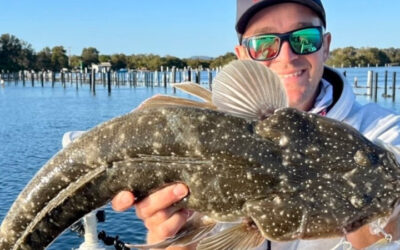
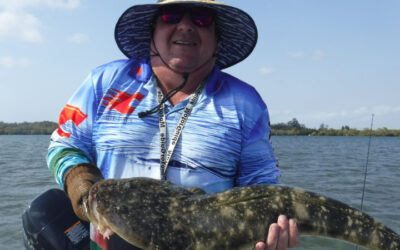
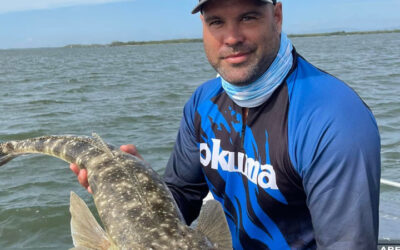
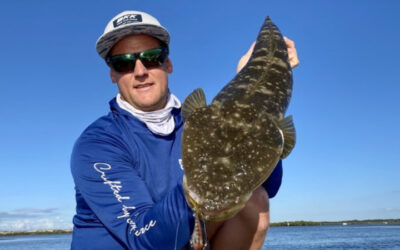
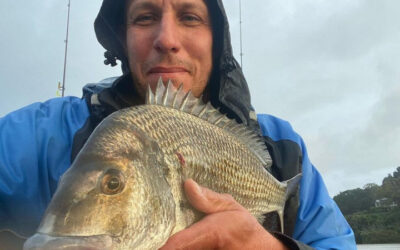
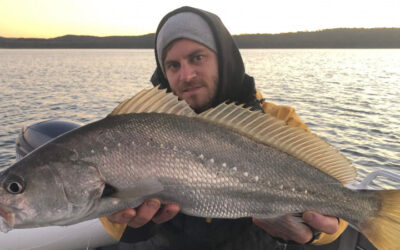
![[Trailer] Episode 621: The Best Flathead Lures With Greg Vinall](https://doclures.com/wp-content/uploads/2023/03/603-understanding-flathead-audio-greg-vinall.featured-400x250.jpg)
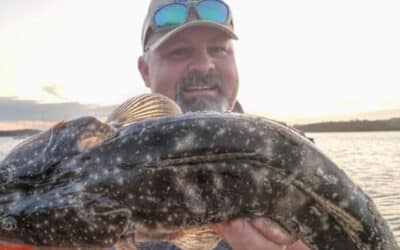
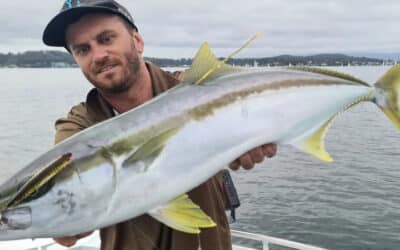
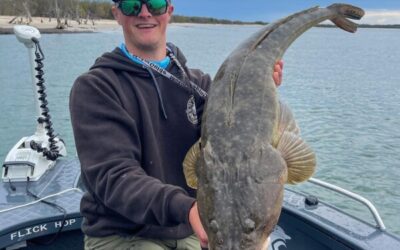
![Episode 563: [Featured Guide] Mallacoota Bream With Chris Jordan](https://doclures.com/wp-content/uploads/2022/11/563-mallacoota-bream-chris-jordan-featured-400x250.jpg)
